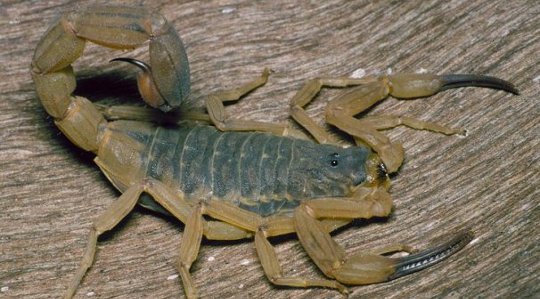 Brazilian yellow scorpion (Tityus serrulatus)
Brazilian yellow scorpion (Tityus serrulatus)
 n the development of new drugs, taking something from nature and modifying it has been a successful tactic employed by medicinal chemists for years. Now, with the help of nanotechnology, researchers are turning once-discarded drug candidates into usable drugs.
n the development of new drugs, taking something from nature and modifying it has been a successful tactic employed by medicinal chemists for years. Now, with the help of nanotechnology, researchers are turning once-discarded drug candidates into usable drugs.
An estimated 40% of clinically approved drugs fall into the category where either the natural compound itself or a modified version is the approved drug. These include statins (found in bacterial secretions) used to lower cholesterol, quinines (found in cinchona trees) as anti-malarials and paclitaxel (found in yew trees) as anti-cancer medication.
Many of these natural products are toxins produced by plants or animals as a form of defence. And scorpion venom has been gaining interest as a source of new drugs. It contains a mixture of biological chemicals called peptides, some of which are known to trigger cell death by forming pores in biological membranes. Cell death can be useful if we are able to target, say, tumour cells to auto-destruct.
These toxins can have very potent effects. For instance, one particular small peptide, known as TsAP-1, isolated from the Brazilian yellow scorpion (Tityus serrulatus), has both anti-microbial and anti-cancer properties.
Get The Latest By Email
However, harnessing this kind of power for clinical good has so far been challenging because these toxins kill both tumours and healthy cells. One method to control such toxicity is through using nanotechnology to build specially made drug-delivery vehicles. If successful, the toxic drug is released to kill only unwanted tissues in a body.
One such attempt has been made by Dipanjan Pan at the University of Illinois at Urbana-Champagne. In a study published in the journal Chemical Communications, scientists claim to have created spherical capsules to trap scorpion venom toxin TsAP-1. This encapsulated toxin, named NanoVenin, increases the drugs effectiveness at killing breast cancer cells by ten times.
This is an interesting development for two reasons. Firstly, the venom toxin in its natural form could not be used due to the lack of specificity and, secondly, the incorporation of the venom toxin in the nanoparticle caused a large increase in the drug’s potency, making it more clinically useful.
This form of the drug works on breast cancer cells, but it is not disease-specific yet. Researchers can modify its outer shell by, for example, attaching proteins that can make it selective towards certain types of cancers. It may also be possible to coat the nanoparticle in a biodegradable layer so as to trap its toxicity until it reaches the diseased area, where the layer degrades to reveal the toxin.
Such precise delivery can work on a “lock-and-key system” of highly precise biological structures. For instance, different types of cancer cells have characteristic secretions or outer proteins – the biodegradable layer of the drug can be built to recognise these specific secretions or proteins and then trigger the degradation process, allowing precise delivery of the drug.
Often effective drugs have been discovered but not commercialised due to delivery issues. Yet the latest developments in nanotechnology illustrate how once discarded drugs sourced from natural compounds can be brought off the shelf to fight disease.
This article was originally published on The Conversation.
Read the original article.
About the Author
Benjamin Burke is a Molecular Imaging Post-Doctoral Research Assistant at University of Hull.
Disclosure Statement: Benjamin Burke does not work for, consult to, own shares in or receive funding from any company or organisation that would benefit from this article, and has no relevant affiliations.
Recommended Book:
Keeping the Bees: Why All Bees Are at Risk and What We Can Do to Save Them
by Laurence Packer.
 While the media focuses on colony-collapse disorder and the threats to honey bees specifically, the real danger is much greater: all bees are at risk, whether it be from loss of habitat, pesticide use or disease, among other factors. And because of the integral role these insects play in the ecology of our planet, we may be at risk as well. In Keeping the Bees, Laurence Packer, a melittologist whose life revolves around bees, debunks many myths about these creatures and takes us behind the scenes with scientists around the world who are working to save these fascinating creatures before it’s too late.
While the media focuses on colony-collapse disorder and the threats to honey bees specifically, the real danger is much greater: all bees are at risk, whether it be from loss of habitat, pesticide use or disease, among other factors. And because of the integral role these insects play in the ecology of our planet, we may be at risk as well. In Keeping the Bees, Laurence Packer, a melittologist whose life revolves around bees, debunks many myths about these creatures and takes us behind the scenes with scientists around the world who are working to save these fascinating creatures before it’s too late.
Click here for more info and/or to order this book on Amazon.







